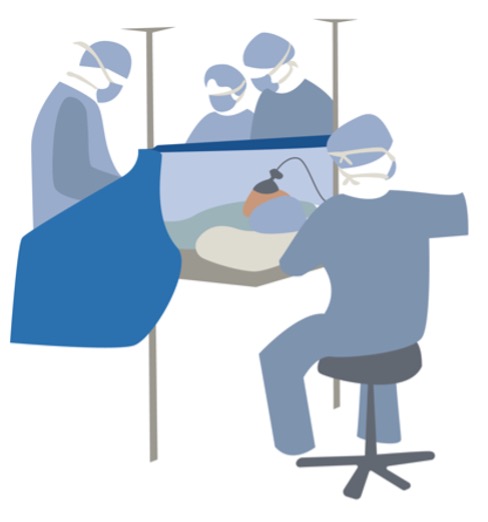The Hanneken Lab
Research Updates
Nature Paper “Revival of Light signaling in the postmortem Mouse and Human Retina”.
 In collaboration with scientists from the Salk Institute and the University of Utah, we have revived human organ donor eyes after death and restored all the electrical activity in the central vision. This groundbreaking work was published in the highly regarded scientific journal Nature in May 2022. The article was titled “Revival of light signaling in the postmortem mouse and human retina” and was reported by over 160 newspapers and magazines around the world, including Scientific American, Reuters News Service and the Wall Street Journal. This research was funded by grateful patients and friends of our lab.
In collaboration with scientists from the Salk Institute and the University of Utah, we have revived human organ donor eyes after death and restored all the electrical activity in the central vision. This groundbreaking work was published in the highly regarded scientific journal Nature in May 2022. The article was titled “Revival of light signaling in the postmortem mouse and human retina” and was reported by over 160 newspapers and magazines around the world, including Scientific American, Reuters News Service and the Wall Street Journal. This research was funded by grateful patients and friends of our lab.
Since this breakthrough, we have focused on extending the lifespan of the revived human donor eyes. Currently, we can maintain light signaling for up to 36 hours after revival, but the electrical activity decreases quickly with time. We have built a system that perfuses the eyes after death to provide constant oxygenation. This unit is based on the principles of ECMO (extracorporeal membrane oxygenation) that is used in the ICU to provide oxygen for people without healthy lungs. Our goal is to engineer this device further and extend the lifespan of the revived human eyes for an extended time period.

Toward Macular Transplantation for the Blind
Excitingly the Hanneken lab has made additional progress toward their goal of transplanting the human macula. In collaboration with scientists from the Salk Institute and the University of Utah, Dr. Hanneken and her team have revived human organ donor eyes after death and restored all the electrical activity in the central vision. This groundbreaking work was published in the highly regarded scientific journal Nature in May 2022. The article, titled “Revival of light signaling in the postmortem mouse and human retina,” was reported by over 160 newspapers and magazines around the world, including both Scientific American, Reuters News Service and the Wall Street Journal. This transformative research was funded by grateful patients and friends of the Hanneken lab.
Since this breakthrough, Dr. Hanneken and her colleagues have focused on extending the lifespan of the revived human donor eyes. Currently, they can maintain light signaling for up to 36 hours after revival, but the electrical activity decreases quickly with time. The team has built a system to provide constant oxygenation to the eyes after death. This unit is based on the principles of ECMO (extracorporeal membrane oxygenation) used in the ICU to provide oxygen for people without healthy lungs. The researchers’ goal is to engineer this device further and lengthen the lifespan of the revived human eyes for an extended time period.
Each step offers new insight as the Hanneken lab continues investigating the feasibility of macular transplantation, a potentially life-changing treatment option for patients suffering from age-related macular degeneration or diabetic retinopathy—the two leading causes of blindness in the developed world.

Improving Visual Chemistry
Over the past year, the Hanneken lab has conducted experiments which could help prove that chemicals within our natural environments—such as compounds found within foods and plants—can affect our ability to see. Dr. Hanneken and her team have discovered a small group of molecules, called allosteric modulators, that act as “dance partners” binding to specific pockets on the surface of the receptors. Much like the movement of a dancer with a dance partner (as seen in Figure 1), allosteric modulators are able to affect the shape, structure and, thus, function of light receptors within eyes.

Figure 1. Illustrations of how dance partners influence the subsequent movements of the dancer. Similar effects are seen when allosteric modulators bind to a receptor and facilitate structural movements, which activate or inhibit the function of a receptor.
This discovery introduces a paradigm-shifting concept to vision science—no one has previously thought to investigate if light receptors (which are integral to our sense of sight) could be altered by chemicals within natural products of our environments. The findings from this research could open new pathways for scientists to significantly improve vision in people who have a limited sense of sight due to certain diseases.
Recent experiments, utilizing the surface plasmon resonance technique and hydrogen-deuterium exchange mass spectrometry, have sought to uncover precisely where these allosteric modulators bind to the light receptor, rhodopsin, and how they change the light receptor’s behavior.
The Hanneken team found one allosteric modulator had the highest binding affinity of the tested group and was strong enough to alter the properties of rhodopsin. The far-reaching implications of this exciting research could provide new insight into our understanding of night and color vision and transform methods for preventing and treating debilitating eye diseases.
Dr. Hanneken and her team continue to study the interactions between allosteric modulators and light receptors. A deeper understanding of these interactions has the potential to create a transformative shift for vision science, validating how natural products affect our sense of sight and offering a unique approach for influencing vision.



